Yellow once again dominates my thoughts and this week I’ve embroidered a dandelion and buttercup. Both flowers are beginning to appear and once established will be with us through the summer into autumn by which time their reproductive success will have alienated all who want to maintain a flawless lawn and a weed free herbaceous border. I’m not to bothered about the perfections of either lawn or border but I do, with the help of a hand wielded apple corer, wage a small personal battle with the more obviously flourishing dandelions on the lawn at the front of the vicarage. Whisper it quietly, but I think I may be winning.
Shaggy petalled dandelions and the ruffled fur of lions’ manes have much visually in common, so I was a bit taken aback to discover firstly, that the ‘dent-de-lion’ comes from the french for lion’s teeth and secondly, forget about those great golden mop heads and tangled fur, and focus on comparing the teeth to … the leaf . Ummmm, but I can’t help but think biologists have missed the bloomin’ obvious here.
Now we all remember that the problem with picking dandelions as children was that your hands got covered with the creamy fluid that leaked from the broken stem tissue but what most of us certainly didn’t realise was that this latex was very similar in structure to that produced by rubber trees and, that it too could be used to manufacture car tyres. During 2014, Continental Tyres worked together with a German research establishment, the Fraunhofer Institute to produce a material they call Taraxagum from which experimental tyres have been made. These have been tested in winter conditions in Germany and Sweden, so watch out for newspaper reports as to their success. Perhaps one day soon we may find bright yellow fields of dandelions next to acid yellow fields of oil seed rape, opposite fields of piercing blue of linseed. Thank goodness for the gentle mauve of the opium poppies, otherwise we country people will only be able to look out of the window wearing sunglasses!
Buttercups have their own bit of magic too. Remember that game with buttercups where you hold them under your chin and marvel at the yellow glow. Recently, researchers at Cambridge have worked out that this glow is the result of the unique anatomical structure of the petal whose different layers work together to give that very distinctive bright glossy sheen.
Apparently, the petal’s epidermal layer is able to reflect light with an intensity similar to that reflecting off glass. As well as this the petal reflects a significant amount of UV light which is very attractive to the main pollinators, including bees. In this way the buttercup has evolved to be a very attractive flower using both shout out loud and more subtle techniques.
Still with yellow flowers, I recently discovered that wild daffodils are also known as Lent Lilies because they bloom and die away between Ash Wednesday and Easter (The Times’s Nature Notebook mid March 2015.) With petals on the clotted cream end of the yellow spectrum and the trumpet more towards cheddar cheese, this gentle little wild flower is the daffy down dilly of nursery rhyme as well as being the one that, “beside the lake, beneath the trees”, in glorious overabundance, stimulated William Wordsworth’s brain into hyperdrive to such wonderful effect. Once again the yellow of such flowers has evolved to be optimal lure to pollinating insects but with these daffodils something else vital to their survival is going on under the ground. In the soil around the roots there are mychorrhizal fungi with which the daffodil lives in a symbiotic relationship – that is one useful to both parties – energy moves primarily from plant to fungus while inorganic resources move from fungus to plant. Both organisms benefit and both suffer if one dies. Lenten lilies won’t thrive where land is sprayed with fungicide and now sadly drifts of the plant as seen by Wordsworth are few and far between. Gloriously there are two small clumps in the vicarage garden (see photo).
Two weeks ago my husband caught fleeting sight of a greenfinch – one those little greeny yellow birds with the bright sulphur green flash on the wing. Last year there were some around our bird feeder but now I gather we must be very careful with our bird feeder hygiene as greenfinches are picking up a most dreadful throat disease (trichomonosis) which makes swallowing difficult. Their normal call is a loud wheezing call but this has nothing to do with the disease. They also have a rollicking song in the air and this is accompanied by curious wing beats and violent lurches of the body from side to side – according to Derwent May’s description from his Nature Notes for the Times of 2 March 2015. I now desperately want to see what he described – perhaps BBC TV could follow the success of the radio ‘Tweet of the Day” with a short film of ‘Flight of the Day” and we could all learn a thing or two.

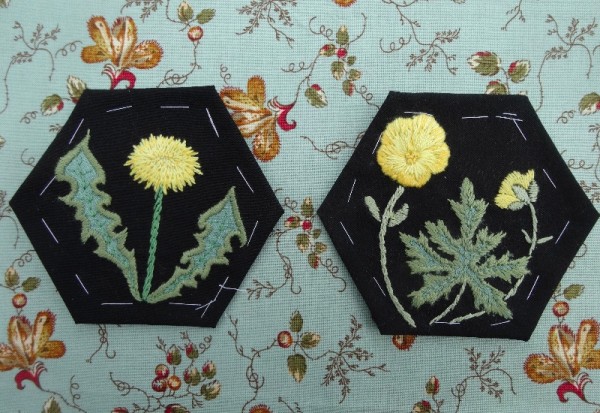
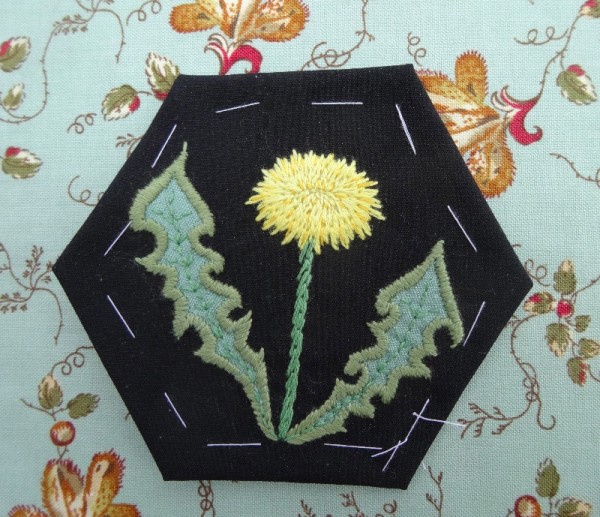
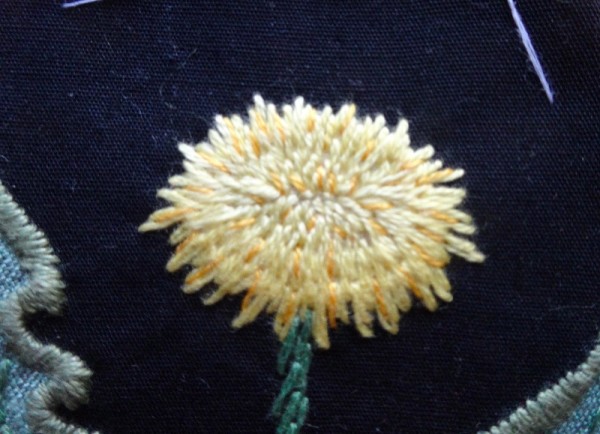
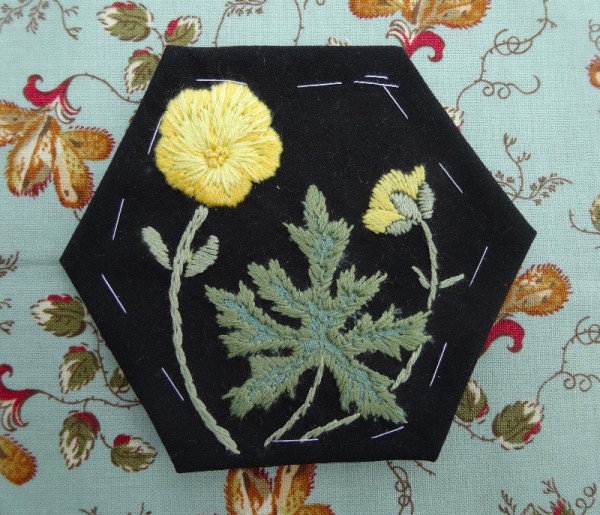
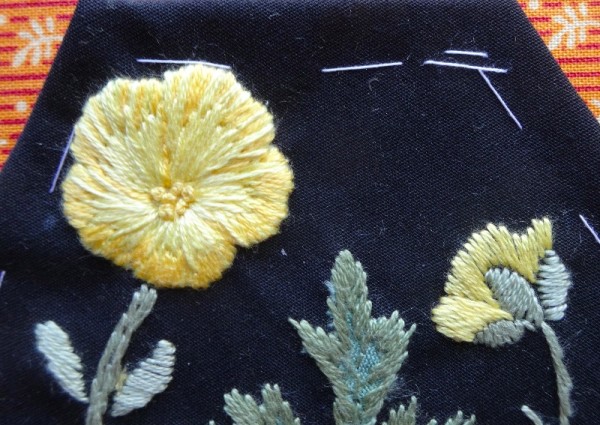
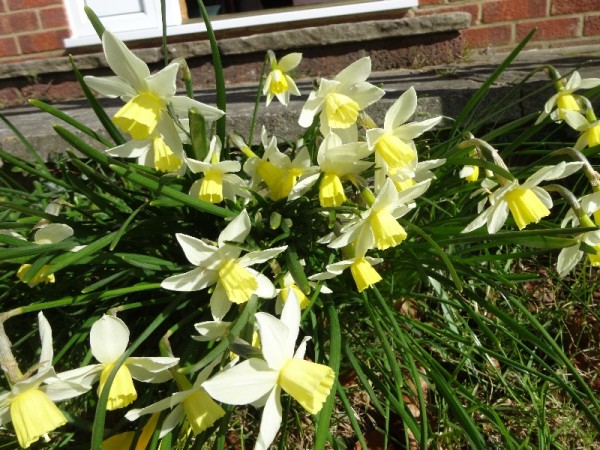
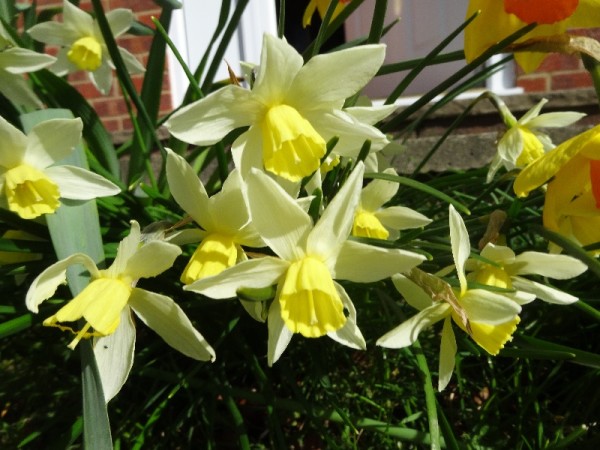
8 Comments
I can imagine that any gardener would prefer your embroidered dandelions to the real ones!
Perhaps you’re right – dandelions are phenomenally successful at seeding themselves.
A post full of springtime optimism and useful information. I never thought of plunging an apple corer into the heart (so to speak) of the dandelion root, but will be trying that in my own garden very soon! X
Beware of apple corers made of soft metal – I’ve been through a few as they buckle in the face of a good thick tap root!
I am very fond of dandelions… plants that grow near them are supposed to grow better due to the deep dandelion tap root bringing up nutrients from the lower levels. However, I think that they probably grow much more luxuriantly in the British front lawns than they do here, sometimes I can tell the time by the dandelion clock though! The milky sap is supposed to be good for removing warts – maybe… Fascinating to read that they were used for making tyres too… Plants are so versatile. I love your little embroideries they fit so nicely into your hexagons… I always confirmed my love for butter by the yellow glow of a buttercup beneath my chin… Very best. Lydia
The dandelion is very lucky to have you speaking up for them Lydia! Luxurious is a good word to use to describe their growth here. I did try them as a wart treatment once and it was a bit of a palava and not successful. However, they are a lovely colour.
I have been a silent follower for some time, I hope you don’t mind, but I couldn’t resist letting you know that greenfinches are relatively common and in good numbers here in New Zealand. They were introduced in the 1860’s, I think, so will be by now distant antipodean cousins of your lot.
Bird calls have been played on Radio New Zealand at 7am and 9 am since 1974. I use the 7am call as my alarm.
Thank you for breaking your silence, Hilary. It’s good to know greenfinches are doing well in New Zealand and in part I think it’s because more farmers let their fields overwinter with stubble which the birds are used to foraging in – it’s on with the next crop here without a break. See here https://books.google.co.uk/books?id=c0k6wARxF9QC&pg=PA101&lpg=PA101&dq=english+greenfinches&source=bl&ots=TX-0XqWOQE&sig=kDqgPUTfoq2s6JInoTSQDut_WSM&hl=en&sa=X&ei=Kn8jVZO3BcvfaPikgPAK&ved=0CEQQ6AEwBzgU#v=onepage&q=english%20greenfinches&f=false